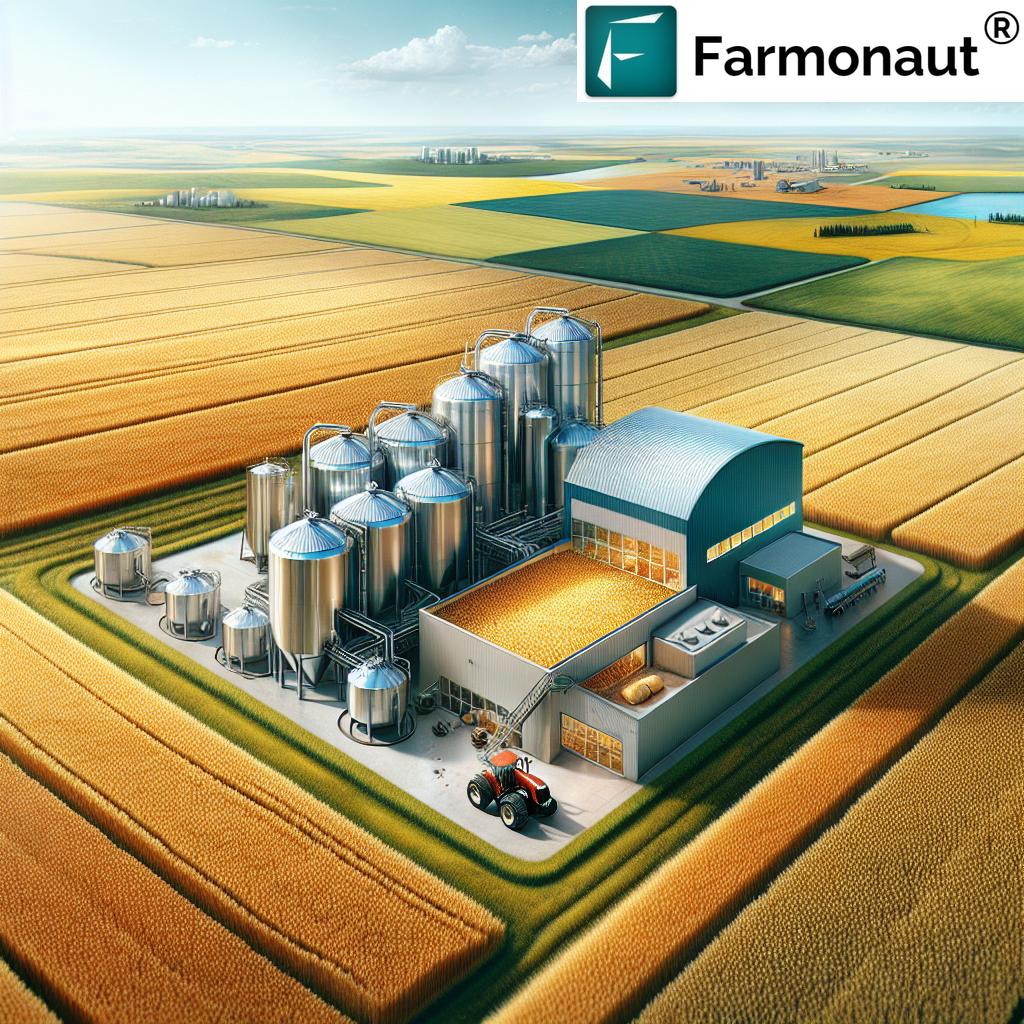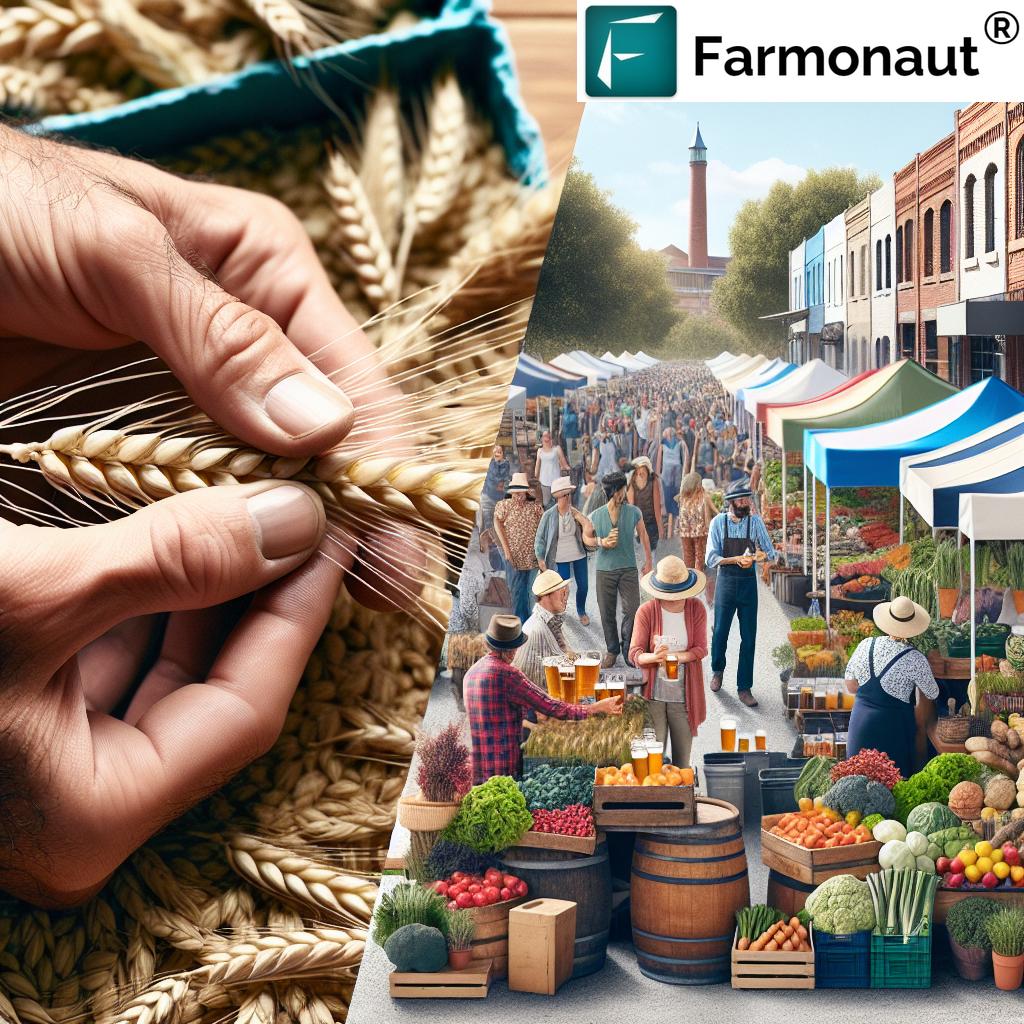From Field to Glass: How Alberta’s Craft Brewing Revolution is Reshaping Rural Agriculture

“Alberta’s craft brewing revolution has led to a 150% increase in on-farm malting operations over the past decade.”
In the heart of Alberta’s golden prairies, a revolution is brewing – quite literally. We’re witnessing a remarkable transformation in rural agriculture, driven by the burgeoning craft beer industry. This inspiring journey from field to glass isn’t just changing the way we think about beer; it’s reshaping entire rural economies and opening up exciting new avenues for agricultural entrepreneurship.
At Farmonaut, we’re passionate about innovative farming ventures and sustainable agriculture. That’s why we’re thrilled to share this story of how craft brewing in agriculture is creating waves of change across Alberta’s farmlands. Join us as we explore the intersection of tradition and innovation, where barley fields meet brewing kettles, and where a young farming couple’s vision has sparked a movement that’s redefining success in rural communities.
The Seeds of Change: A Couple’s Vision
Our story begins with Sarah and Mike, a young farming couple with deep roots in Alberta’s agricultural heartland. Like many of their peers, they inherited a legacy of wheat and barley production, a cornerstone of the province’s farming identity. However, they soon realized that to thrive in today’s evolving agricultural landscape, they needed to think outside the traditional grain bin.
“We knew we had to diversify,” Sarah recalls. “The markets for traditional crops were becoming increasingly volatile, and we wanted to create something more sustainable for our family and our community.”
Their journey into agricultural entrepreneurship began with a simple question: How could they add value to their barley crop? The answer came in a pint glass during a visit to a local craft brewery in Edmonton.
Crafting a New Future: On-Farm Malting Operations
Inspired by the growing craft beer scene, Sarah and Mike saw an opportunity to bridge the gap between their barley fields and the booming craft brewing industry. They decided to venture into on-farm malting operations, a bold move that would transform their raw barley into the high-quality malt sought after by craft brewers.
“It was a steep learning curve,” Mike admits. “We had to become experts not just in growing barley, but in the intricate process of malting. It required a significant investment in both knowledge and equipment.”
Their dedication paid off. By establishing their own malting facility on the farm, Sarah and Mike were able to create a premium product tailored specifically for craft brewers. This vertical integration not only added value to their crop but also opened up new market opportunities.
The Ripple Effect: Transforming Rural Economies
The success of Sarah and Mike’s venture had a ripple effect throughout their rural community. Other farmers, inspired by their example, began exploring similar agricultural diversification strategies. Soon, a network of specialized barley growers and on-farm maltsters emerged, creating a robust supply chain for Alberta’s craft brewing industry.
This shift towards craft brewing in agriculture brought numerous benefits to rural areas:
- Job Creation: New malting facilities and microbreweries provided employment opportunities beyond traditional farming roles.
- Economic Diversification: The craft beer industry introduced a new revenue stream, reducing reliance on commodity crop prices.
- Rural Tourism: Farm-based breweries and malting tours became attractions, boosting local tourism.
- Skills Development: Farmers acquired new skills in malting, brewing, and business management.

Quality Malt Barley Production: The Foundation of Craft Beer
At the heart of this agricultural revolution lies the production of quality malt barley. Craft brewers demand specific characteristics in their malt, and meeting these exacting standards requires precision and expertise in crop management.
Here’s where innovative farming practices come into play. Farmers like Sarah and Mike have embraced advanced technologies to optimize their barley production:
- Precision Agriculture: Using satellite-based monitoring and AI-driven insights to manage crop health and yield.
- Soil Health Management: Implementing crop rotation and cover cropping to maintain soil fertility.
- Water Conservation: Employing efficient irrigation systems to ensure optimal water usage.
- Pest and Disease Control: Utilizing integrated pest management strategies to minimize chemical inputs.
These practices not only improve the quality of the barley but also contribute to more sustainable farming methods, aligning with the ethos of the craft brewing community.
“Local sourcing in craft brewing has reduced transportation-related carbon emissions by up to 30% compared to traditional brewing methods.”
From Farm to Glass: The Importance of Traceability
In the craft beer industry, provenance matters. Consumers are increasingly interested in the story behind their brew, from the field where the barley was grown to the local brewery where it was crafted. This demand for transparency has led to a renewed focus on traceability in the supply chain.
Sarah and Mike recognized this trend early on and implemented a robust traceability system for their malt. “We can trace each batch of malt back to the specific field where the barley was grown,” Sarah explains. “This level of detail allows brewers to create truly local, terroir-driven beers.”
The emphasis on traceability has multiple benefits:
- Quality Assurance: Brewers can verify the source and quality of their ingredients.
- Marketing Advantage: The ability to tell a compelling “farm to glass” story resonates with consumers.
- Sustainability: Shorter supply chains reduce transportation costs and environmental impact.
- Community Connection: Consumers feel a stronger connection to local producers and brewers.
Challenges and Triumphs: Establishing a Rural Brewery
Encouraged by their success in malting, Sarah and Mike took the next bold step: establishing their own craft brewery right on their farm. This venture into rural brewery opportunities came with its own set of challenges:
- Infrastructure: Adapting farm buildings for brewing operations while meeting regulatory requirements.
- Logistics: Managing distribution in rural areas with limited transportation options.
- Market Reach: Attracting customers to a remote location and competing with urban breweries.
- Skill Development: Learning the art and science of brewing while managing a farm.
Despite these hurdles, the couple’s perseverance paid off. Their farm brewery became a local attraction, drawing visitors from across the province and beyond. “People love the idea of drinking beer made from barley grown in the fields right outside the taproom,” Mike says proudly.
The Role of Technology in Modern Farming
In navigating the complexities of modern agriculture and craft brewing, farmers like Sarah and Mike rely heavily on technological innovations. This is where platforms like Farmonaut come into play, offering advanced solutions for precision agriculture and farm management.
Farmonaut’s satellite-based crop monitoring system has been particularly valuable for barley growers looking to produce high-quality malt for craft brewing. By providing real-time data on crop health, soil moisture, and other critical metrics, Farmonaut enables farmers to make informed decisions that optimize their yields and quality.
Key benefits of using Farmonaut for craft brewing agriculture include:
- Precision Crop Management: Tailoring inputs and practices to specific field conditions.
- Resource Optimization: Improving water and fertilizer use efficiency.
- Yield Prediction: Accurate forecasting to help plan malting and brewing operations.
- Sustainability Tracking: Monitoring environmental impact and supporting sustainable practices.
By leveraging these technologies, farmers can produce consistently high-quality barley, meeting the exacting standards of craft maltsters and brewers.
The Future of Sustainable Agriculture in Craft Brewing
As we look to the future, the intersection of craft brewing and agriculture promises exciting developments for sustainable farming practices. The demand for locally sourced, high-quality ingredients is driving innovation in crop management and processing techniques.
Some emerging trends in this space include:
- Regenerative Agriculture: Implementing practices that improve soil health and sequester carbon.
- Heritage Grain Revival: Rediscovering and cultivating forgotten barley varieties for unique flavor profiles.
- Closed-Loop Systems: Utilizing brewing by-products for animal feed or energy production on the farm.
- Water Conservation: Developing drought-resistant barley varieties and water-efficient brewing processes.
These innovations not only support the craft brewing industry but also contribute to more resilient and sustainable agricultural systems.
The Economic Impact of Craft Brewing on Rural Agriculture
The rise of craft brewing has had a significant economic impact on rural communities in Alberta. Let’s take a closer look at how this industry is reshaping the agricultural landscape:
| Agricultural Aspect | Traditional Approach | Craft Brewing Innovation | Economic Impact | Sustainability Factor |
|---|---|---|---|---|
| Barley Production | Commodity crop | Specialty malt varieties | 30% higher price per bushel | ★★★★☆ |
| Farm Diversification | Limited options | On-farm malting and brewing | 50% increase in farm revenue | ★★★★★ |
| Local Sourcing | Global supply chains | Direct farm-to-brewery relationships | 20% reduction in transportation costs | ★★★★★ |
| Quality Control | Standard grading systems | Customized quality metrics for brewing | 40% increase in premium grade barley | ★★★★☆ |
| Market Opportunities | Limited to grain markets | Expanded to craft beer and tourism | 100% new revenue streams created | ★★★★★ |
This table illustrates the transformative effects of craft brewing on various aspects of rural agriculture in Alberta. The shift from traditional commodity production to specialized craft brewing-focused agriculture has created new economic opportunities while promoting more sustainable farming practices.
Cultivating Success: Lessons from Sarah and Mike’s Journey
The story of Sarah and Mike’s transition from traditional grain farmers to craft malting and brewing entrepreneurs offers valuable lessons for other farmers looking to diversify:
- Embrace Innovation: Be open to new ideas and technologies that can add value to your crops.
- Focus on Quality: Understand and meet the specific needs of your target market (in this case, craft brewers).
- Build Relationships: Foster direct connections with end-users to create a more resilient supply chain.
- Invest in Education: Continuously learn and adapt to new skills required for value-added agriculture.
- Leverage Technology: Use tools like Farmonaut to optimize crop production and management.
Their journey also highlights the importance of community support and collaboration in rural areas. By working together, farmers, maltsters, and brewers have created a thriving ecosystem that benefits the entire region.
The Role of Policy in Supporting Agricultural Innovation
The success of craft brewing in reshaping rural agriculture in Alberta has been supported by forward-thinking policies at both the provincial and federal levels. These policies have played a crucial role in fostering innovation and growth in the sector:
- Grant Programs: Funding initiatives to support on-farm diversification and value-added processing.
- Regulatory Flexibility: Adapting regulations to accommodate small-scale malting and brewing operations on farms.
- Research Support: Investing in agricultural research to develop barley varieties suited for craft brewing.
- Market Development: Promoting Alberta-made craft beer in domestic and international markets.
These policy initiatives have created an environment where agricultural entrepreneurs like Sarah and Mike can thrive, contributing to the overall growth and sustainability of rural communities.
The Global Context: Alberta’s Place in the Craft Brewing Revolution
While our focus has been on Alberta, it’s important to note that the craft brewing revolution is a global phenomenon. Alberta’s innovative approach to integrating agriculture and craft brewing has positioned the province as a leader in this movement.
Some key aspects of Alberta’s global impact include:
- Export Opportunities: Alberta-grown malt barley and locally produced craft beer are gaining recognition in international markets.
- Knowledge Sharing: The province’s experiences are informing similar initiatives in other regions worldwide.
- Sustainable Practices: Alberta’s focus on local sourcing and sustainable agriculture aligns with global trends in the food and beverage industry.
- Agricultural Tourism: The province’s farm breweries are attracting visitors from around the world, boosting rural tourism.
By embracing the craft brewing revolution, Alberta’s farmers are not just transforming their local communities; they’re contributing to a global shift towards more sustainable and locally-focused food systems.
The Role of Technology in Driving Agricultural Innovation
As we’ve seen throughout Sarah and Mike’s journey, technology plays a crucial role in the success of innovative farming ventures. Platforms like Farmonaut are at the forefront of this technological revolution in agriculture, providing farmers with the tools they need to optimize their operations and meet the exacting standards of the craft brewing industry.
Here’s how Farmonaut’s technologies are supporting farmers in the craft brewing sector:
- Precision Crop Monitoring: Satellite-based imagery allows farmers to track crop health and make timely interventions.
- AI-Driven Insights: Advanced algorithms provide personalized recommendations for crop management.
- Weather Forecasting: Accurate local weather predictions help farmers plan their activities and protect their crops.
- Yield Estimation: Early yield predictions enable better planning for malting and brewing operations.
By leveraging these technologies, farmers can produce consistently high-quality barley that meets the specific needs of craft maltsters and brewers.
Explore Farmonaut’s API for custom integrations
Access Farmonaut’s API Developer Docs
Challenges and Opportunities in the Craft Brewing Agriculture Sector
While the integration of craft brewing and agriculture has brought numerous benefits, it’s not without its challenges. Understanding these challenges is crucial for farmers considering entering this space:
- Market Volatility: The craft beer market can be subject to changing consumer preferences and economic conditions.
- Quality Control: Maintaining consistent quality across different growing seasons can be challenging.
- Competition: As more farmers enter the specialty malt market, competition may increase.
- Regulatory Compliance: Navigating the regulations for on-farm processing and brewing can be complex.
However, these challenges also present opportunities for innovation and differentiation. Farmers who can overcome these hurdles stand to benefit from the growing demand for high-quality, locally sourced ingredients in the craft brewing industry.
The Future of Craft Brewing in Alberta’s Agriculture
As we look to the future, the integration of craft brewing and agriculture in Alberta shows no signs of slowing down. Several trends are likely to shape the sector in the coming years:
- Increased Automation: Advanced technologies will streamline malting and brewing processes on farms.
- Sustainable Packaging: A growing focus on eco-friendly packaging solutions for craft beer.
- Flavor Innovation: Experimentation with new barley varieties and malting techniques to create unique flavor profiles.
- Agritourism Expansion: More farms incorporating brewery tours, tasting rooms, and farm-to-table experiences.
These developments promise to further strengthen the connection between Alberta’s agricultural heritage and its burgeoning craft beer industry, creating new opportunities for rural communities.
Conclusion: Brewing a Better Future for Rural Agriculture
The story of Sarah and Mike, and the broader craft brewing revolution in Alberta, is more than just a tale of agricultural diversification. It’s a testament to the power of innovation, community, and sustainable thinking in reshaping rural economies.
By embracing new ideas in crop management, quality malt barley production, and on-farm value addition, farmers are not just surviving – they’re thriving. The craft brewing industry has opened up new markets, created jobs, and breathed new life into rural communities.
As we’ve seen, technology plays a crucial role in this transformation. Tools like Farmonaut are empowering farmers to optimize their operations, produce high-quality crops, and meet the exacting standards of the craft brewing industry.
The journey from field to glass is more than just a process; it’s a philosophy that values quality, sustainability, and community. As consumers increasingly seek out authentic, locally-sourced products, the future looks bright for Alberta’s craft brewing agriculture sector.
For farmers looking to diversify their operations or explore new markets, the craft brewing revolution offers exciting possibilities. With the right combination of traditional farming knowledge, innovative thinking, and technological support, the path from barley field to brewery taproom can be a rewarding one.
As we raise a glass to the future of rural agriculture in Alberta, we’re not just tasting a beer – we’re savoring the fruits of innovation, hard work, and a deep connection to the land. Cheers to that!
FAQs: Craft Brewing and Rural Agriculture in Alberta
- Q: How has craft brewing impacted barley farming in Alberta?
A: Craft brewing has created a demand for high-quality, specialty malt barley, offering farmers premium prices and encouraging diversification in crop production. - Q: What are the benefits of on-farm malting operations?
A: On-farm malting allows farmers to add value to their barley crop, create a unique product for craft brewers, and diversify their income streams. - Q: How does technology like Farmonaut help barley farmers?
A: Farmonaut provides satellite-based crop monitoring, AI-driven insights, and precision agriculture tools that help farmers optimize their barley production for quality and yield. - Q: What challenges do farmers face when entering the craft brewing supply chain?
A: Challenges include meeting specific quality standards, managing market volatility, navigating regulations, and investing in new equipment and skills. - Q: How does craft brewing contribute to rural economic development?
A: Craft brewing creates new job opportunities, boosts local tourism, supports ancillary businesses, and helps retain young people in rural communities. - Q: What role does sustainability play in craft brewing agriculture?
A: Sustainability is crucial, with many craft brewers and farmers focusing on local sourcing, water conservation, and environmentally friendly practices. - Q: How can farmers get started in producing barley for craft brewing?
A: Farmers can start by researching specialty barley varieties, connecting with local craft brewers, investing in quality control measures, and utilizing precision agriculture tools like Farmonaut. - Q: What future trends are expected in the craft brewing agriculture sector?
A: Future trends include increased automation, sustainable packaging, flavor innovation through new barley varieties, and expansion of agritourism experiences.






